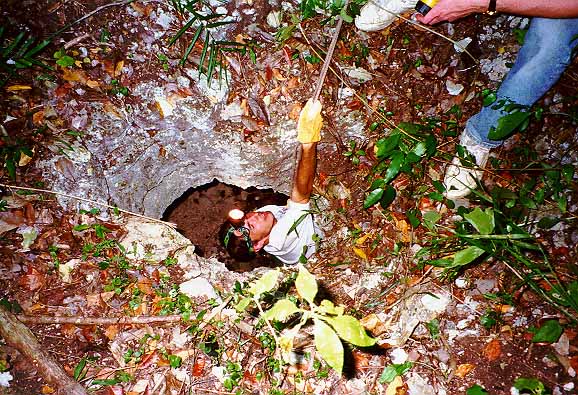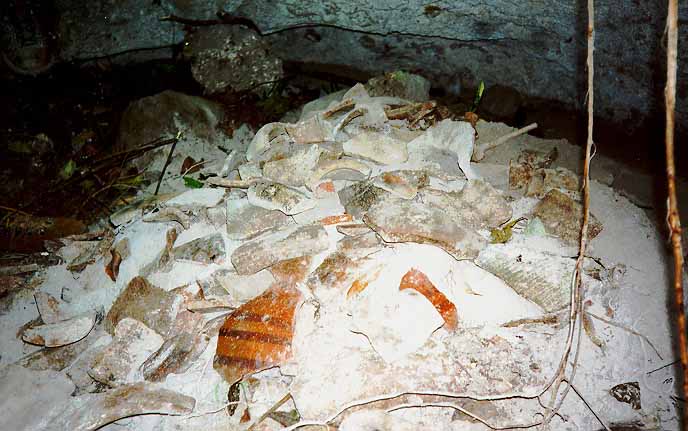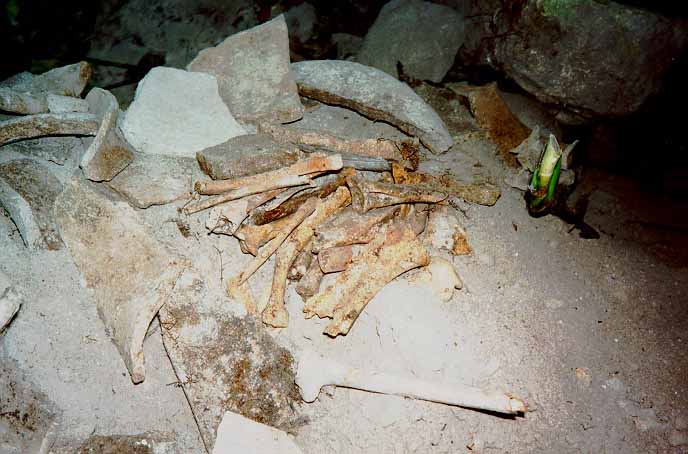
CHULTUNS |
Click on the photograph to see it in greater detail.
Links will work faster if you allow the entire page to load.
 |
During the Late Preclassic, the Ancient Maya of the Yucatán Peninsula began carving out underground storage facilities called Chultuns. These chambers were carved out of the relatively soft Limestone bedrock, then often plastered with a thick coating of lime stucco. The exact purpose of these extremely common storage chambers still eludes archaeologists. Most were probably used to collect and store rain water. The northern portion of the Yucatán Peninsula has a marked dry season, and portions have a quite meager rainy season. What water does fall, sinks into the limestone bedrock almost immediately and joins with the groundwater in the immense systems of caves which riddle the peninsula. Consequently, surface water is scarce, and chultuns were positioned in sculpted plazas and sideyards which would drain the precious fluid into the narrow openings for storage. It is also possible that the chultuns were used to store other goods and seal them away from pests. In many cases this can be ruled out due to the amount of water which would have collected in these chambers and quickly rotted any dry food-stuffs. |
 |
Inside the chultun, one will usually find a conical mound of trash and sediment. This trash can date from any time after the termination of the chultun as a storage facility. Once the plaster has eroded and water is no longer held, or the chultun becomes too infested or damp to store perishables, the large chamber is a convenient place to sweep away daily refuse. As you can see in this photo, the broken cookware and storage vessels that once belonged to an ancient Maya family were swept into this chultun along with the deerbones and turtle shells that must have once been dinner. Other chultuns nearer to current settlements have a nearly continuous deposit of trash, with the uppermost layer exhibiting Coke bottles and egg shells. Occasionally one will find human remains in these trash deposits. In a land where the topsoil is rarely a meter deep, this may have simply been a convenient way of interring someone in the ground, but in truth we do not know exactly why these individuals were given burials in chultuns while others were buried under houses or in courtyards. |
 |
The chultun that you see here has been looted for some unknown artifacts. It is not likely that the looter found anything of value in this mound of ancient household refuse. Most of the vessels are broken utilitarian jars and bowls, not the beautiful polychrome vessels that you would find in a tomb or in other elite contexts. These diggers have succeeded in disturbing the original context of the trash, which would have allowed archaeologists to better study this feature. Because of this inevitable result, the market for illegal antiquities should be stopped by all means possible. On the other hand, since these chambers are still used by the Maya today for disposing their refuse, who exactly can blame them for going through their own trash for objects of value today? I pose this as a moral dilemma, not an excuse for the ever present problem of archaeological looting. |